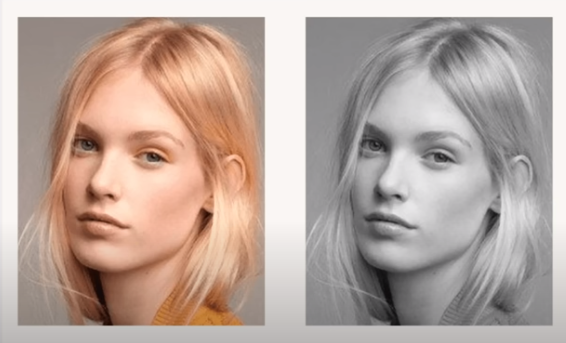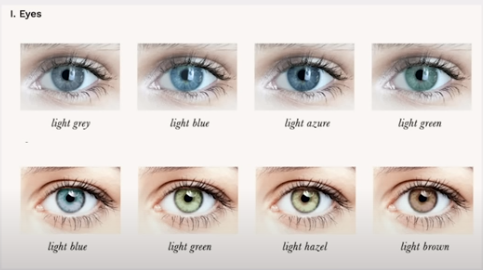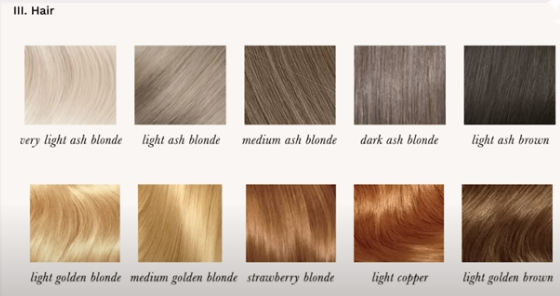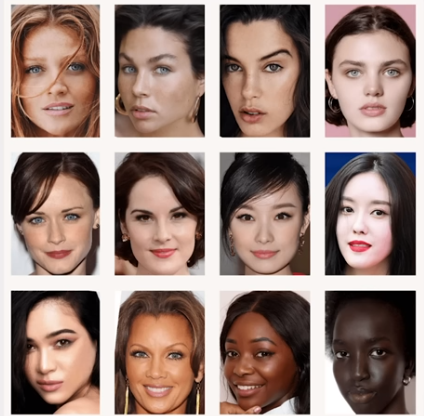Color analysis is the best method to find the colors that work best for you. You will be assigned to one of twelve color seasons based on different elements. Don’t worry—it doesn’t have to be difficult.
The first step to find your season is to define your features. Look at your natural features—nothing that’s dyed. Examine yourself fair-faced in natural light. Also, consider how your features change over time, whether that means from infancy until now or throughout the year, as some people’s skin and hair color fluctuate. You want an overall picture.
To define your season, consider these three main characteristics: warm or cool, light or dark, and bright or muted.
1. Warm vs. Cool
Warm: Your dominant characteristic is warm if the first thing that strikes you is the obvious warmth radiating from your features with no coolness. Your skin has a yellow, golden, earthy, or peachy undertone. The overall contrast of your features is medium.

Your eyes can be light to medium brown, olive green, dark hazel, light hazel, or warm blue.

Your hair ranges from light to medium golden blonde, brown, strawberry blonde, to rich red, copper, or deep auburn. Darker ethnicities may have deep golden brown or brown-black hair with warm undertones.
Cool: Your dominant characteristic is cool if the first thing that strikes you is the distinctive coolness of your features with no warmth. Your skin has grayish, blue, pink, or red undertones. The overall contrast level is medium to high.

With hair that can be ash blonde, chestnut brown, silver, or gray. Darker ethnicities may have dark brown or black hair.

Your eyes can be blue, gray, hazel, or soft dark brown. Gold makes you look yellowish and sickly, while silver makes you shine.

2. Light vs. Dark
Dark is closer to black, light is closer to white. The closer a feature is to black, the more you would consider it dark. The closer to white, the lighter you would consider that feature. Consider your hair, eyes, and skin.
Light: Your dominant characteristic is light if the first thing you notice is the absence of depth in your features. Your skin, eyes, and hair are light for your ethnicity, with a low contrast between them.



Eyes can be light to medium blue or green, light hazel, or light brown.

Your hair is very light to medium ash or golden blonde, soft light auburn, or light to medium brown.

Dark colors age you, but light colorful tones make your appearance pop.
Dark: Your dominant characteristic is dark if the first thing you notice is the depth of your hair and eyes. This doesn’t mean all dark-skinned people are dark; it means your features are darker relative to your ethnicity. Your contrast between skin, hair, and eyes is medium to high.

Eyes can be black, black-brown, red-brown, brown, dark green, or dark hazel.

Hair can be very dark black, brown-black, chestnut brown, or dark auburn. Very dark colors make your features pop, while light colors wash you out.

3. Muted vs. Bright
Muted: Your dominant characteristic is muted if the first thing you notice is how grayed out your appearance is. Your features blend together with a low to medium contrast level.



Eyes can be hazel, brown, gray-green, or gray-blue. Hair can be neither very light nor very dark, usually ashy, golden, or ash blonde through to dark brown, or soft auburn. Muted colors give you a sophisticated elegance, while bright colors draw attention away from you.


Bright: Your dominant characteristic is bright if the first thing you notice is the clearness and saturation of your features. There is no grayness, and your features contrast clearly against each other. Your contrast level is high to very high.

Eyes can be clear blue, turquoise blue, green, bright green, emerald, sparkly amber, topaz brown, or dark brown. Hair can be black, black-brown, medium to dark brown, bright golden blonde, or red hair. You can wear saturated colors without them stealing the show, but muted colors wash you out.


Step Two is to order your features from the most dominant to the less dominant. Now that you’ve gone through each feature—hair, skin, eyes—and labeled it light or dark, you should determine if you seem generally light or dark, cool or warm, bright or soft overall, and write that down. Identify your dominant feature, the one that stands out to you first, and the one that was easiest to determine. Clarify what you’re ranking: light and dark, cool and warm, soft or bright. Find which of these different categories defines your features the most. If your features lean very black, very gray, and only a little cool, soft and dark are more dominant for you than cool and warm. Maybe it’s easier to think of it the other way around: which is neutral for you?
Match your order with the 12 seasons (only the first two features , neglect the third one )

Now that you have discovered your season, you can explore more about it by doing a quick online search. You’ll find a wealth of information and palettes that can help you choose the best colors for your wardrobe and makeup. Stay tuned for our next article, where we’ll dive deeper into each color, providing detailed insights and tips on how to incorporate them into your style.
